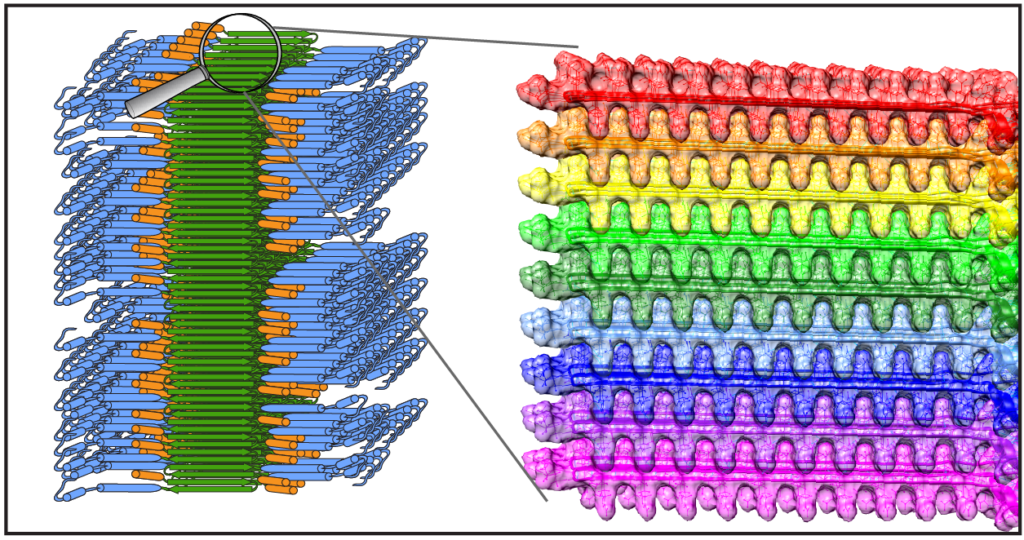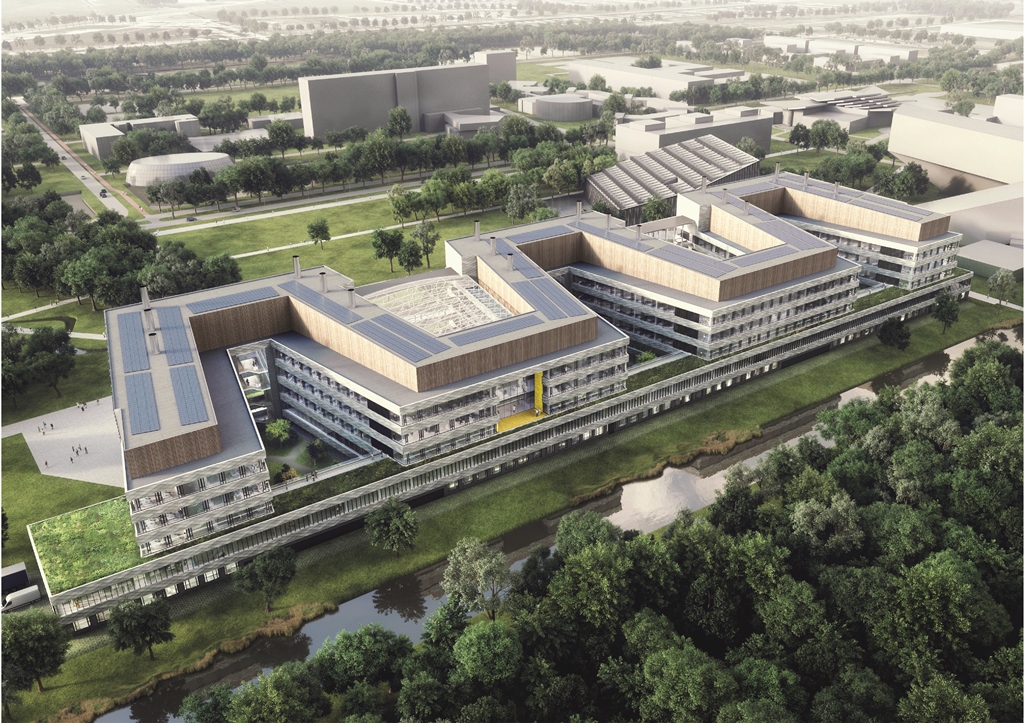news
New publication on structure of mutant huntingtin protein from Huntington’s Disease
Congratulations to Dr. Jennifer Boatz and other team members for the acceptance and publication of a nice new paper on the structure of the misfolded mutant protein from Huntington’s disease. The paper is online at the Journal of Molecular Biology. Based on an integration of multiple techniques (NMR, EM, and X-ray diffraction), Jennifer assembled a new structural model of the protofilaments that make up the hierarchical fiber architecture of mutant huntingtin exon 1. This is a timely and important step forward in our understanding of the (mis)behaviour of the HD protein, and in particular how it forms pathogenic inclusions and protein aggregates.
In this new paper and prior work we (and others) have seen that the mutant protein is prone to form a collection of different kinds of aggregates, with each their own structure and functional properties. This is of substantial interest from a disease perspective, as these “functional properties” can encompass different degrees of neurotoxic properties. Surprisingly, Jennifer shows in this paper that one contributor to, or trigger of, huntingtin polymorphism is the concentration of the protein. Further studies will have to explore whether or how this finding impacts efforts to replicate cellular behaviour of the protein in vitro, and how it may affect the toxic properties of the aggregated protein states.

Reference:
Protofilament Structure and Supramolecular Polymorphism of Aggregated Mutant Huntingtin Exon 1. Boatz, J.C., Piretra, T., Lasorsa, A., Matlahov, I., Conway, J.F. & Van der Wel, P.C.A. (2020) J. Mol. Biol., 432(16): 4722-4744. [DOI] (Open Access)
Funding & support: The underlying research in this paper was enabled by funding support from the American NIH/NIGMS (grant R01 GM112678) and funding from the CampagneTeam Huntington in the Netherlands. For more information on the disease, see also our HD page and the CTH website. Other support came from the University of Groningen and the University of Pittsburgh.
Note added: Our Institute also highlighted this paper in a nice summary posted on the Zernike Institute website.
New review paper on ssNMR studies of polysaccharide hydrogels
PhD student Mustapha El Hariri El Nokab has put together a nice new review of solid-state NMR studies of polysaccharide hydrogels, which is now out in the journal Carbohydrate Polymers. This review is part of his research project that make use of solid-state NMR (and other tools) to look at functional polysaccharide hydrogels. This new research direction in the lab also constitutes part of our participation in the new Physics of Cancer (www.phycan.nl) initiative of the Zernike Institute for Advanced Materials.
Please find the open-access published paper at the journal Carbohydrate Polymers:
Competitive PhD Scholarships call open (deadline April 1st)
Our Institute and Faculty have opened up a competitive call for PhD scholarship applications. Our solid-state NMR group participates in one of the research theme areas, designated as “Advanced Materials”, which spans topics from physics of life, via bio-inspired materials, to materials and much more. The process is described in some detail on the RuG website. Briefly, applicants (with a MSc degree) are expected to contact a PI/supervisor (immediately!) and develop a fitting project to submit. The submission deadline of an initial idea (few hundred words) is due by April 1st 2020!
Suitable ideas are expected to fit within designated topics areas, described on the website here and here. Note especially also the 2nd link, as it contains important detailed information.T
Interested in this? Please contact us as soon as possible, to meet the tight deadlines. Together we can consider topics that range from self-assembling bio-inspired materials, Physics of Cancer, non-biological materials and other topics. Projects will be highly interdisciplinary as the involvement of a second supervisor is also required, with a distinct and complementary expertise.
New Publication on Lipid Oxidation
Now online in the journal Free Radical Biology and Medicine: a new review and perspective article by our collaborator Valerian Kagan (Univ. Pittsburgh). The paper (titled “Redox phospholipidomics of enzymatically generated oxygenated phospholipids as specific signals of programmed cell death”) examines the role of controlled lipid oxidation as a source of vital cellular signals. In particular it reviews recent work showing how cardiolipins and phosphatidylethanolamine lipids are oxidised by enzymes, as triggers of apoptosis and ferroptosis. Interestingly, the enzymatically generated oxidised species are distinct from those generated by spontaneous peroxidation, which may be important for the regulatory role of these species.
For more details, read the whole article here:
Kagan et al. (2020) “Redox phospholipidomics of enzymatically generated oxygenated phospholipids as specific signals of programmed cell death” Free Radical Biology and Medicine, Vol. 147, pp. 231-241
MAS ssNMR @ RuG arrived and operational (mostly)
Instrumentation update:
Our new 600 MHz NMR spectrometer from Bruker Biospin has arrived and been installed in building 5113 on the Zernike campus of the University of Groningen. The system features a new high-performance NEO-style console, with the necessary solid-state NMR (ssNMR) accessories. Although the ordered magic-angle-spinning (MAS) ssNMR probes are not yet available, a preliminary MAS ssNMR probe has been successfully installed.
For now, a few components are still missing, and the field remains a bit unstable. However, preliminary experiments have started! Further updates to follow.
For more information on our capabilities and for information about usage please contact the PI (p.c.a.van.der.wel@rug.nl) and/or our NMR technician (a.lasorsa@rug.nl).
Publication: New review article on the structural biology of Huntington’s disease.
Now online at the journal Experimental Biology and Medicine: our new review article summarizing recent contributions from solid-state NMR and electron microscopy to further our understanding of the (mis)behavior of the mutant proteins behind Huntington’s disease.
Citation:
I. Matlahov & P.C.A. van der Wel (2019) Conformational studies of pathogenic expanded polyglutamine protein deposits from Huntington’s disease. Exp. Biol. Med. in press; DOI: 10.1177/1535370219856620
Publication: cytochrome c-cardiolipin complexes as pro-apoptotic lipid peroxidase.
Our first paper of 2019 has just appeared online in the journal Structure. It describes the very nice solid-state NMR studies performed by Dr. Mingyue Li, on a protein-lipid complex involved in the early stages of mitochondrial apoptosis. Together with our collaborators in the groups of Valerian Kagan and Jinwoo Ahn (University of Pittsburgh), she looked at the structure and function of the peroxidase active cytochrome c in its membrane-bound state. For more details on the findings, including how the lipid substrate cardiolipin forms membrane nano domains and acts as a dynamic regulator, please see the paper at the journal. This work was made possible by NIH funding (NIGMS R01 GM113908).
Reference:
Surface-Binding to Cardiolipin Nanodomains Triggers Cytochrome c Pro-apoptotic Peroxidase Activity via Localized Dynamics. Li, M., Mandal, A., Tyurin, V.A., Delucia, M., Ahn, J., Kagan, V.E., & Van der Wel, P.C.A. (2019) Structure, in press [URL]
Additional information/press info:
New PhD position available – polyglutamine structural biology.
Update: this position has been filled!
26/02/2019: A new fully-funded PhD position in the lab is available in our project studying the structure of polyglutamine amyloid proteins involved in Huntington’s disease. This research position will focus to a large extent on continuing and expanding the structural ssNMR methods that we previously reported in:
• Hoop et al. Huntingtin exon 1 fibrils feature an interdigitated β-hairpin-based polyglutamine core. Proc. Natl. Acad. Sci. USA. 2016 Feb 9;113(6):1546–51.
This will involve the development, testing and application of advanced ssNMR structural measurements. Aside from the ssNMR development work, structural measurements will be integrated with mechanistic and biological assays, similar to prior our paper:
• Lin et al. Fibril polymorphism affects immobilized non-amyloid flanking domains of huntingtin exon1 rather than its polyglutamine core. Nat Commun. 2017 May 24;8:15462.
The applicant is also expected to be comfortable with the English language and enthusiastic about working in a collaborative team environment. The ideal candidate would have a relevant MSc degree in physics or chemistry, experience with NMR spectroscopy, and a genuine interest in (bio)physics and protein structural biology. Interested individuals with a different, but relevant, background are encouraged to inquire. Inquiries, questions, and applications should be sent by email to p.c.a.van.der.wel@rug.nl. Applications should include a CV, a cover letter describing your motivation for being interested in the project and contact information for two or three reference writers.
Also posted here.
12/03/2019 – update – the funding organisation (Campagneteam Huntington) has posted a news item about their support of this research project.
Update on New Feringa Building
Exciting news about the upcoming construction of a brand new building for the lab and the Institute. Construction of the new Feringa Building at the RUG will commence later this year, to be completed in 2021. For more see link:
https://www.rug.nl/groundbreakingwork/190222_feringa_building_construction_agreement
Looking for NMR research technician (MSc/PhD)
More information to follow later, but we just posted the official advertisement for a new research technician with a NMR/SSNMR background. For details see here:
https://www.rug.nl/about-us/work-with-us/job-opportunities/overview?details=00347-02S0006SAP
The deadline is Feb 14th, 2019. Applications should be done via the above URL.
